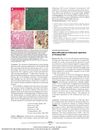TLDR Trichostasis spinulosa is common but often underdiagnosed, mainly affecting women's faces.
The study conducted at Al-Kuwait University Hospital in Yemen aimed to determine the occurrence and characteristics of trichostasis spinulosa (TS) among patients. Out of 2400 patients examined, 286 (11.9%) were diagnosed with TS, with a higher prevalence in women (6.3%) compared to men (4.2%). The face was the most commonly affected area, particularly the nasal alae (96.2%) and nasal tip (90.9%). Only 15.7% had forehead lesions, and 4.5% had perioral lesions. Among the 38 patients who had received prior treatment, 65.8% reported temporary improvement. The study concluded that TS is a common condition affecting the face across all ages, and further research with larger, multi-center cohorts is needed to better understand its prevalence.
9 citations
,
January 2012 in “International journal of trichology” Trichostasis spinulosa can be diagnosed with a simple skin biopsy and treated with specific gels, but lesions may return after stopping treatment.
 13 citations
,
December 2010 in “Archives of Dermatology”
13 citations
,
December 2010 in “Archives of Dermatology” Minoxidil use can cause trichostasis spinulosa in long-term hair loss patients.
25 citations
,
September 1973 in “Archives of dermatology” Using tretinoin cream on the skin can get rid of hair plugs caused by Trichostasis spinulosa.
 April 2024 in “Indian dermatology online journal”
April 2024 in “Indian dermatology online journal” A rare hair follicle disorder can cause itchy, bluish-black bumps on the body.
1 citations
,
May 2017 in “InTech eBooks” The chapter explains common scalp conditions, including infections, infestations, and tumors.
15 citations
,
August 2011 in “Lasers in medical science” The 755-nm alexandrite laser effectively and quickly treats trichostasis spinulosa with minimal pain and no side effects.
9 citations
,
January 2012 in “International journal of trichology” Trichostasis spinulosa can be diagnosed with a simple skin biopsy and treated with specific gels, but lesions may return after stopping treatment.
 8 citations
,
July 2014 in “Anais Brasileiros de Dermatologia”
8 citations
,
July 2014 in “Anais Brasileiros de Dermatologia” A man's scalp condition was misidentified as hair loss dots but was actually a common follicular disorder.


